Be Energy : Be Ecology
Be Energy: committed stakeholder
How do we contribute to achieving the
Sustainable Development Goals (SDGs)?
Regenerating energy for a sustainable future
At Be Energy, the French specialist in industrial and professional battery regeneration, we place sustainability at the heart of our approach.
Our unique technology actively contributes to seven Sustainable Development Goals (SDGs) defined by the United Nations: 3, 6, 7, 8, 9, 12, and 13.
These goals guide our innovations, our partnerships, and our positive impact on the planet.
SDG 3 – Good Health and Well-being
Promoting health and well-being through safer energy solutions
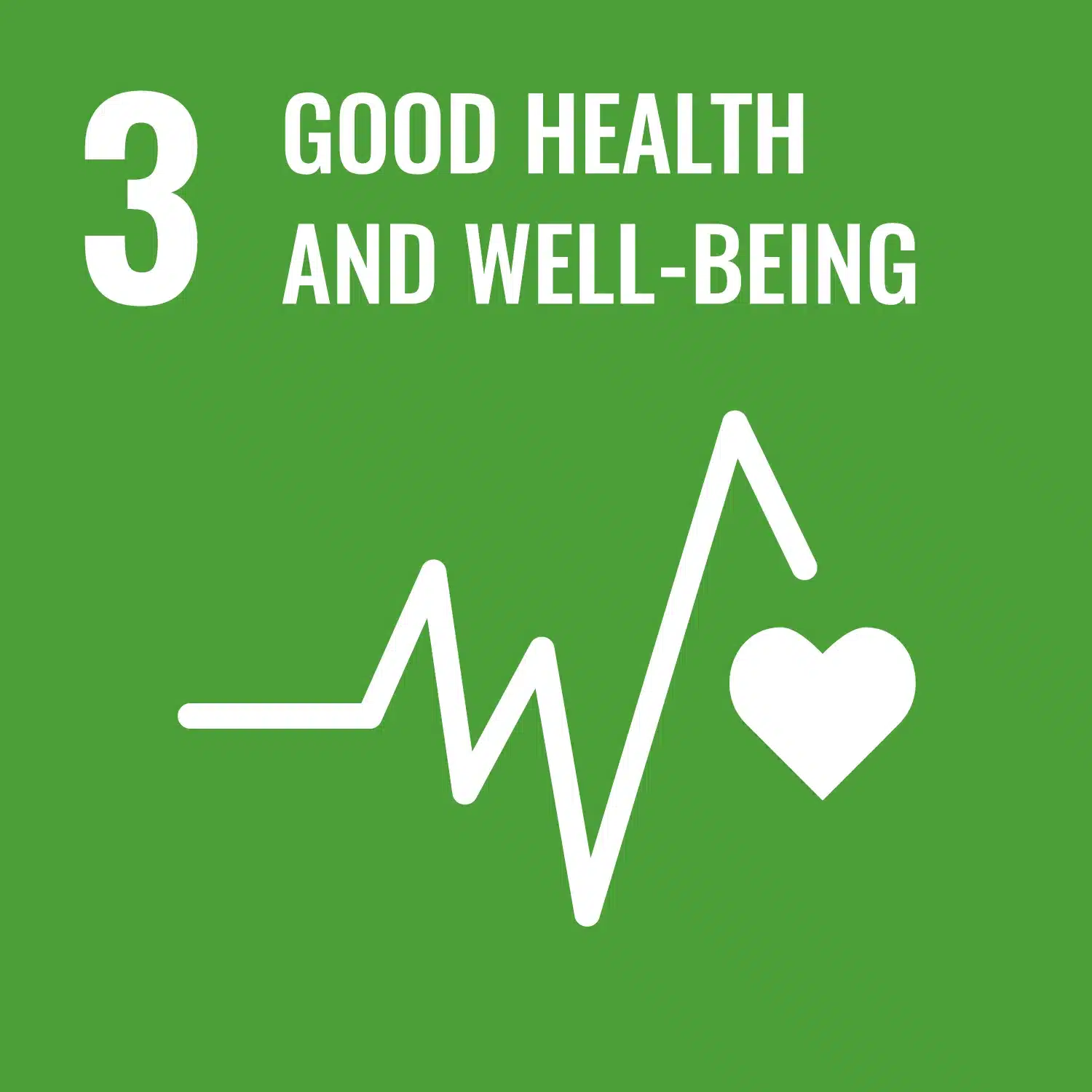
Sustainable Development Goal 3 (SDG 3), “Good Health and Well-Being,” aims to ensure healthy lives and promote well-being for all at all ages. It focuses on reducing communicable and noncommunicable diseases, preventing environmental and occupational hazards, and strengthening health and safety systems.
SDG 3 encompasses physical, mental, and environmental health. It targets the reduction of diseases caused by air, water, and soil pollution, the prevention of exposure to hazardous chemicals, and the promotion of safe working conditions. This goal highlights the link between public health, industrial sustainability, and the quality of professional processes.
Thanks to our lead-acid battery regeneration and lithium battery reconditioning technology, we are actively contributing to SDG 3 by reducing the major health risks inherent in the battery industry:
-
- Protection of workers and the environment: By extending the life of batteries and avoiding their incineration or landfill disposal, we limit exposure to heavy metals (lead, lithium, cadmium) and acids, which are responsible for poisoning and chronic diseases.
- Reducing chemical pollution: Fewer batteries produced or disposed of means a significant reduction in toxic leaks into soil and groundwater, thereby reducing the incidence of diseases linked to environmental contamination.
- Occupational health and safety: The automated desulfation and regeneration processes we use minimize the handling of hazardous substances and improve the safety of our operators and maintenance professionals.
- Collective well-being and public health: By reducing the volume of hazardous waste in the community, we directly contribute to air quality, ecosystem protection, and the establishment of a healthier living environment for the entire community.
The result is a significant reduction in toxic waste, particulate emissions, and chemical exposure, while preserving natural environments and securing industrial infrastructure. With our sustainable battery regeneration solution, we actively support a preventive approach to health, which is perfectly aligned with the global goals of Agenda 2030. In fact, we are simultaneously contributing to the protection of human life, the safety of professionals, and the preservation of the environment.
SDG 6 – Clean water and sanitation
Protecting water resources through regeneration
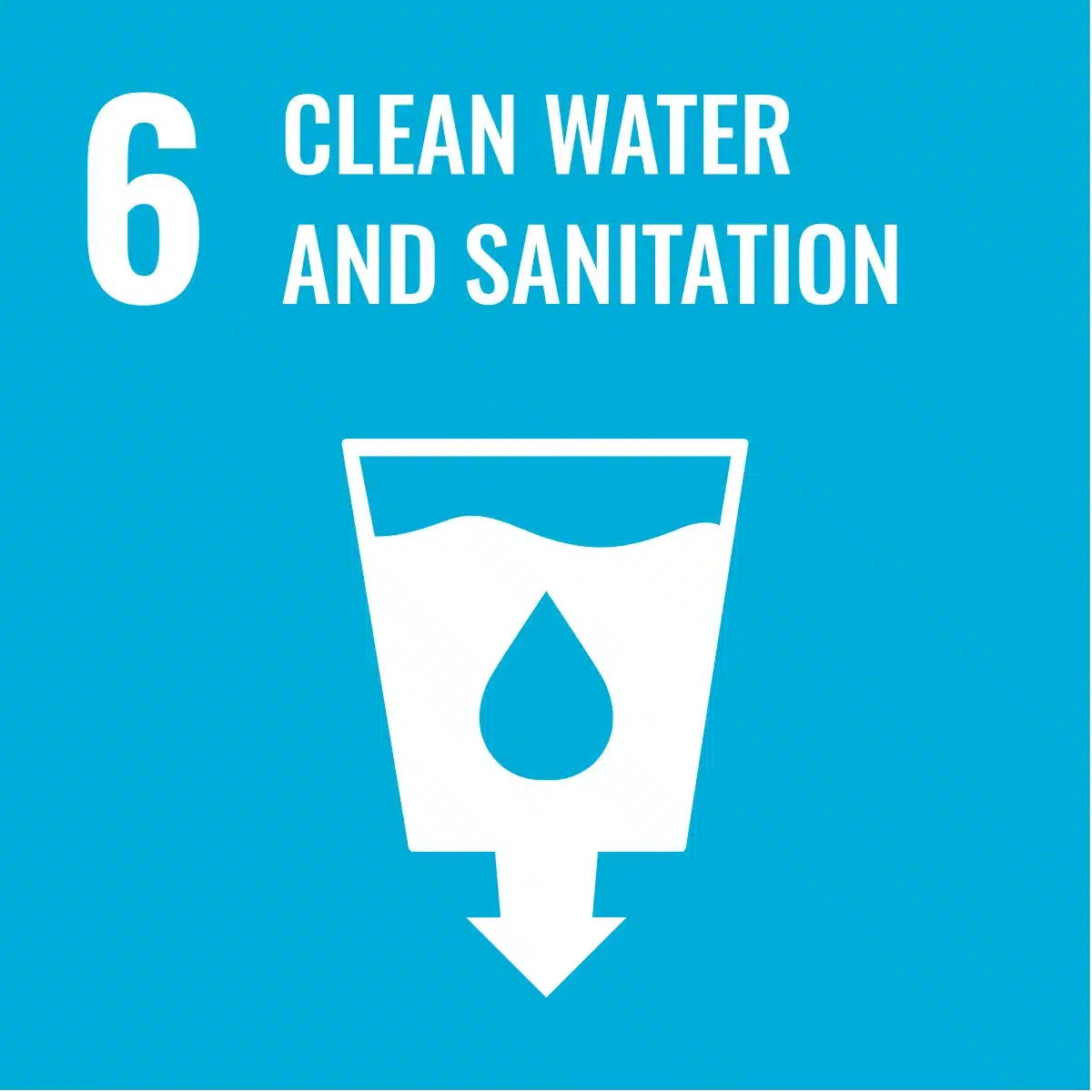
Sustainable Development Goal 6 (SDG 6), “Clean Water and Sanitation,” aims to ensure universal access to safe drinking water, hygiene, and sanitation, while ensuring sustainable management of water resources. It focuses on reducing water pollution, improving wastewater treatment, optimizing water use, and preserving aquatic ecosystems essential to human life and health, such as groundwater, wetlands, rivers, and lakes.
Global demand for water is increasing, while industrial and chemical discharges are compromising the quality of available resources. SDG 6 therefore encourages water conservation and the restoration of aquatic ecosystems by promoting the circular and rational use of water in industrial processes, as well as innovative solutions to reduce water stress on a global scale.
By applying our lead-acid battery regeneration and lithium battery reconditioning technology, we are making a significant impact on SDG 6 by reducing both industrial water consumption and water pollution:
-
- Elimination of water-intensive processes: The manufacture of a new battery is inherently a water-intensive process, requiring a large volume of water for lead refining, electrode plate production, and industrial cooling. By extending the life of existing batteries, we avoid these “water-costly” processes, thereby saving an essential resource.
- Prevention of chemical discharges into water: Regeneration prevents the dispersion of heavy metals (lead, cadmium, lithium) and sulfuric acids. This prevention is crucial, as it limits the pollution of water resources (groundwater and waterways) and the degradation of aquatic ecosystems.
- Reduction of the overall water footprint: Each battery we regenerate results in a significant reduction in the amount of water required and the toxic discharges usually associated with the production and disposal phases.
- Protection of natural environments: By reducing the overall demand for virgin materials and, consequently, the impact of mining sites, we indirectly contribute to the preservation of sensitive water ecosystems such as watersheds, aquifers, and wetlands.
By replacing systematic replacement with battery regeneration, we are actively participating in a circular water economy: less production, less pollution, and greater resilience of water resources for future generations. Our approach is fully in line with the vision of SDG 6, which aims for a world where water, a vital resource, is protected, valued, and managed sustainably for all.
SDG 7 – Affordable and clean energy
Making energy cleaner, more reliable, and accessible to all
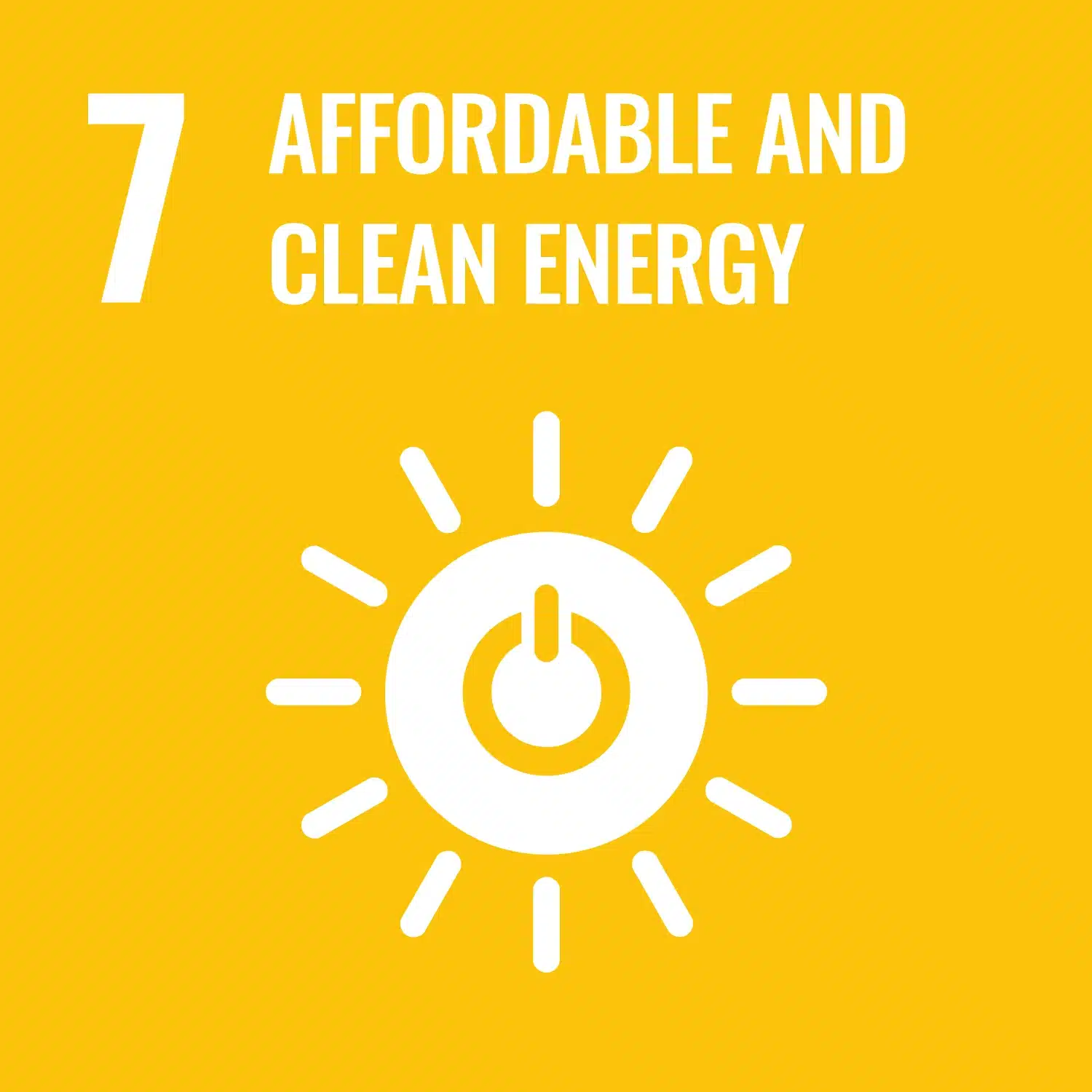
Sustainable Development Goal 7 (SDG 7), “Affordable and Clean Energy,” aims to ensure universal access to reliable, sustainable, and affordable energy for all by 2030. It encourages the development of renewable energies, improved energy efficiency, and reduced dependence on fossil fuels, which are responsible for more than 70% of global greenhouse gas emissions.
SDG 7 places energy at the heart of human and economic development and is structured around key targets:
-
- Universal access to affordable, modern energy (target 7.1)
- Increasing the share of renewable energy in the energy mix (target 7.2)
- Improving global energy efficiency (target 7.3)
- International cooperation and investment in clean technologies (targets 7.a and 7.b)
By applying our battery regeneration technology, we are effectively accelerating the transition to clean and sustainable energy:
-
- Optimization of renewable energy storage: Regeneration extends the life of stationary batteries used in solar, wind, or hybrid systems. This ensures more efficient and sustainable storage of intermittent energy sources.
- Reduced demand for new batteries: By extending their life cycle, we limit the extraction and processing of raw materials, which are highly energy-intensive and CO2-emitting processes.
- Energy accessibility and competitiveness: The reduction in battery maintenance and replacement costs that we enable makes clean storage solutions accessible and competitive, particularly for small businesses, communities, and isolated areas.
- Increased energy reliability: The batteries we regenerate offer extended autonomy and enhance security of supply, which is essential, including in areas with limited electrical infrastructure.
En appliquant le principe d’économie circulaire aux batteries, nous combinons performance technologique et responsabilité environnementale. Cette approche réduit la pression sur les ressources énergétiques, stabilise les réseaux électriques et démocratise l’accès à une énergie propre, abordable et durable, condition essentielle pour lutter contre le changement climatique et favoriser la prospérité collective.
By applying the principle of circular economy to batteries, we combine technological performance with environmental responsibility. This approach reduces pressure on energy resources, stabilizes electricity grids, and democratizes access to clean, affordable, and sustainable energy — an essential condition for combating climate change and promoting collective prosperity.
SDG 8 – Decent work and economic growth
Creating sustainable, local jobs through the circular economy
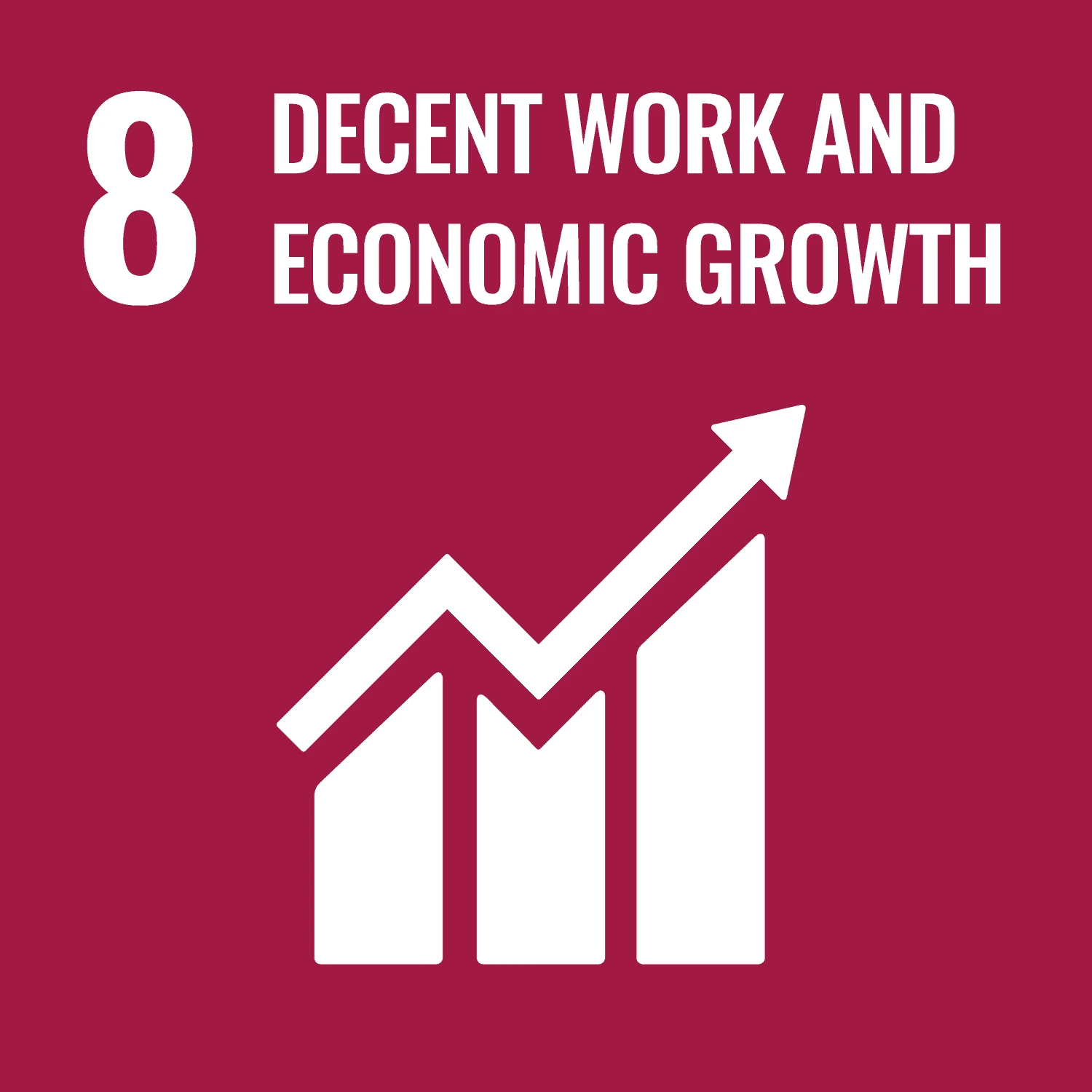
Sustainable Development Goal 8 (SDG 8), “Decent Work and Economic Growth,” aims to promote sustainable, inclusive, and shared growth, while ensuring productive, secure, and fair employment for all. It supports innovation, skills development, the enhancement of human capital, and the creation of economic activities that respect the environment and dignity at work.
SDG 8 seeks to reconcile economic development with respect for human and environmental resources, with key targets:
-
- Sustained and diversified economic growth (targets 8.1 and 8.2)
- Decent job creation and promotion of sustainable entrepreneurship (target 8.3)
- Training and access to employment for young people (target 8.6)
- Workplace safety and protection of workers’ rights (target 8.8)
- Innovation and productivity in high value-added sectors, particularly green sectors
By applying our lead-acid battery regeneration and lithium battery reconditioning technology, we embody future-oriented growth, combining industrial performance with the development of local skills:
-
- Creation of sustainable local jobs: The regeneration centers we set up around the world promote the relocation of skilled, non-outsourceable jobs, thereby strengthening the regional circular economy.
- Training and knowledge transfer: Through our technical training programs and the licensing of our patented technology, we train technicians and engineers specializing in energy maintenance and environmentally friendly processes.
- Green and inclusive growth: Each new regeneration center we deploy supports local employment while reducing the environmental impact of new battery production, combining economic prosperity with sustainability.
- Support for industries of the future: By boosting the clean energy storage industry, we are helping to create an innovative industrial ecosystem based on the circular economy and responsible employment.
Be Energy’s model fully reflects the philosophy of SDG 8: an economy that creates value without destroying natural resources. By combining innovation, skilled employment, and sustainability, Be Energy shows that ecological transition can be a lever for growth, while enhancing regional attractiveness and balanced human development.
SDG 9 – Industry, innovation, and infrastructure
Innovating for a more sustainable industry
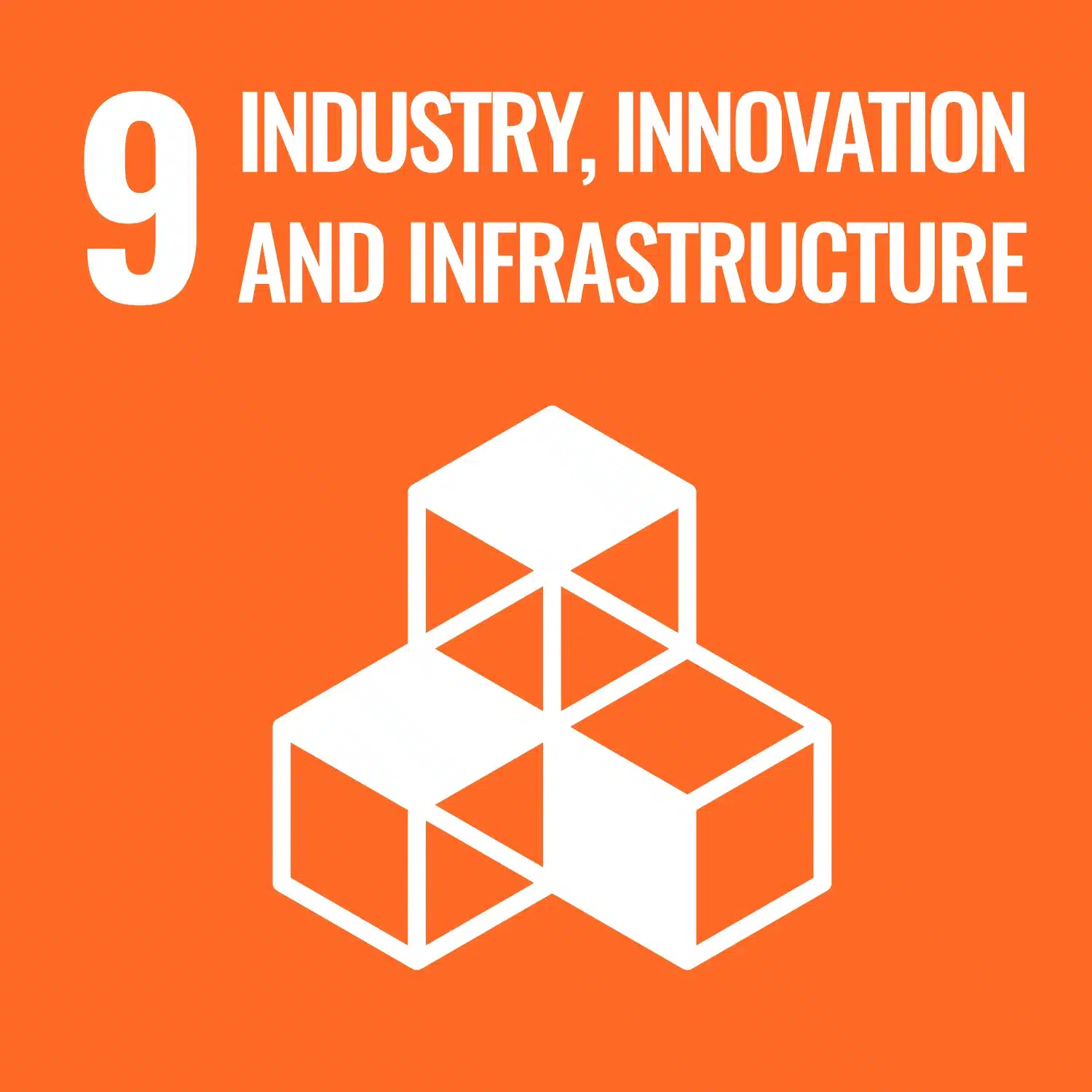
Sustainable Development Goal 9 (SDG 9), “Industry, Innovation and Infrastructure,” promotes infrastructure modernization, the transition to sustainable industrialization, and the stimulation of technological innovation. It aims to build a more resilient, inclusive, and resource-efficient industry, while making research and development an essential lever for economic growth and social progress.
SDG 9 is based on three main areas:
-
- Developing sustainable and resilient infrastructure (target 9.1): designing reliable, energy-efficient and accessible equipment that is essential for regional development.
- Promoting clean and inclusive industrialization (targets 9.2 and 9.4): increasing the contribution of the industrial sector to employment and growth while reducing its environmental footprint.
- Stimulating research and technological innovation (targets 9.5 and 9.b): strengthening innovation capacities, facilitating the financing of green technologies, and encouraging the transfer of sustainable know-how.
As a committed stakeholder in industrial and energy transition, we are working to bring this vision to life through our battery regeneration technology:
-
- Sustainable and circular industrialization: Be Energy’s patented processes replace new manufacturing with regeneration, limiting the use of critical resources and significantly reducing the carbon footprint of industrial chains.
- Modernization of energy infrastructure: Be Energy’s regenerative maintenance solutions improve the performance and sustainability of electrical, logistical, and industrial infrastructure, while reducing operating costs.
- Continuous technological innovation: our company invests in applied research on energy sustainability, develops industrial partnerships, and advances its processes by opening new regeneration centers around the world.
- Dissemination of green and local innovation: by promoting cooperation and the transfer of clean technologies, Be Energy stimulates the creation of a network of regional players committed to a circular, low-carbon, and efficient industry.
By combining technology, innovation, and sustainability, Be Energy acts as a true catalyst for the circular economy. Our model helps reduce raw material consumption, enhance the value of existing equipment, and support infrastructure resilience.
In this way, we fully embrace the vision of SDG 9: building a cleaner, more innovative, and more inclusive industry that promotes sustainable and shared growth.
SDG 12 – Responsible consumption and production
Reducing waste, extending product life
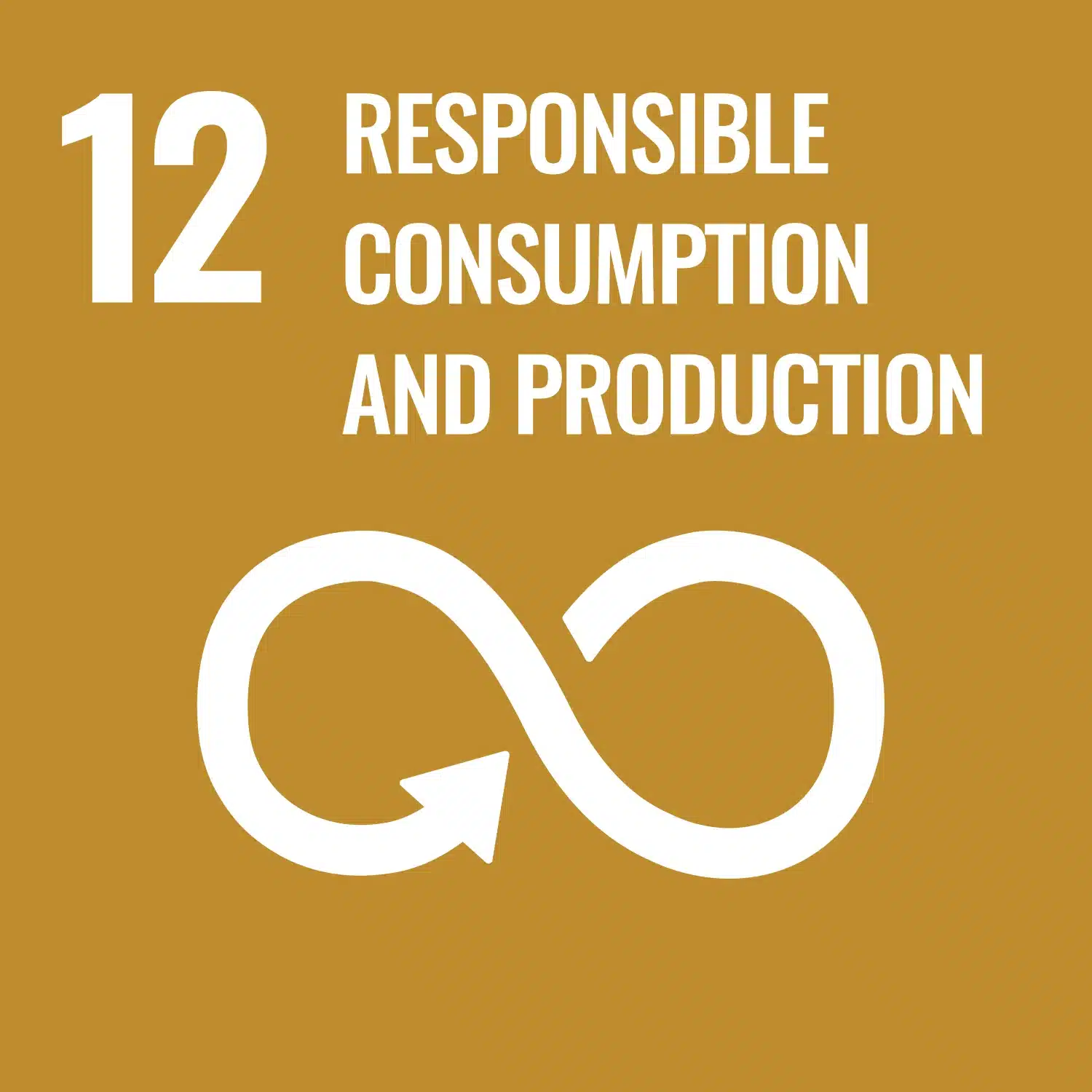
Sustainable Development Goal 12 (SDG 12), “Responsible consumption and production,” encourages the implementation of sustainable economic models based on waste reduction, resource recovery, and product circularity.
Its ambition is to enable us to “do more and better with less” by decoupling economic growth from environmental degradation and the depletion of natural resources.
SDG 12 focuses on key priorities:
-
- Sustainable management of natural resources (target 12.2);
- Reducing waste generation through prevention, reuse, and recycling (target 12.5);
- Adoption of sustainable practices by businesses and transparency on their environmental impacts (target 12.6);
- Promotion of responsible consumption among citizens and public actors (target 12.8);
- Development of the circular economy as a driver of planet-friendly production.
Through its model based on lead-acid battery regeneration and lithium battery reconditioning, Be Energy perfectly embodies the principles of responsible and circular production:
-
- Extending product life cycles: Regeneration gives existing batteries up to twice their original lifespan, reducing premature disposal and minimizing electronic waste.
- Reducing dependence on critical raw materials: By avoiding the need for new battery production, Be Energy helps limit the extraction of heavy metals (lead, nickel, lithium), preserves natural resources, and protects mining ecosystems.
- Cleaner and more efficient production: The patented regeneration technology consumes little energy, produces no chemical effluents, and operates within a framework of energy efficiency and zero toxic discharge.
- Promoting a circular economy model: By integrating regeneration into the supply chains of businesses and local authorities, Be Energy demonstrates that a sustainable industry can successfully combine economic performance with environmental responsibility.
Thanks to our eco-responsible and circular approach, we are transforming production practices toward a more efficient, local, and sustainable model.
Regenerating instead of producing means:
-
- extending the lifespan of products,
- reducing raw material consumption,
- limiting pollution at its source.
Be Energy fully embodies the philosophy of SDG 12: consuming and producing differently to preserve natural resources and build a balanced future between economy, environment, and society.
SDG 13 – Climate Action
Taking concrete action to reduce CO₂ emissions
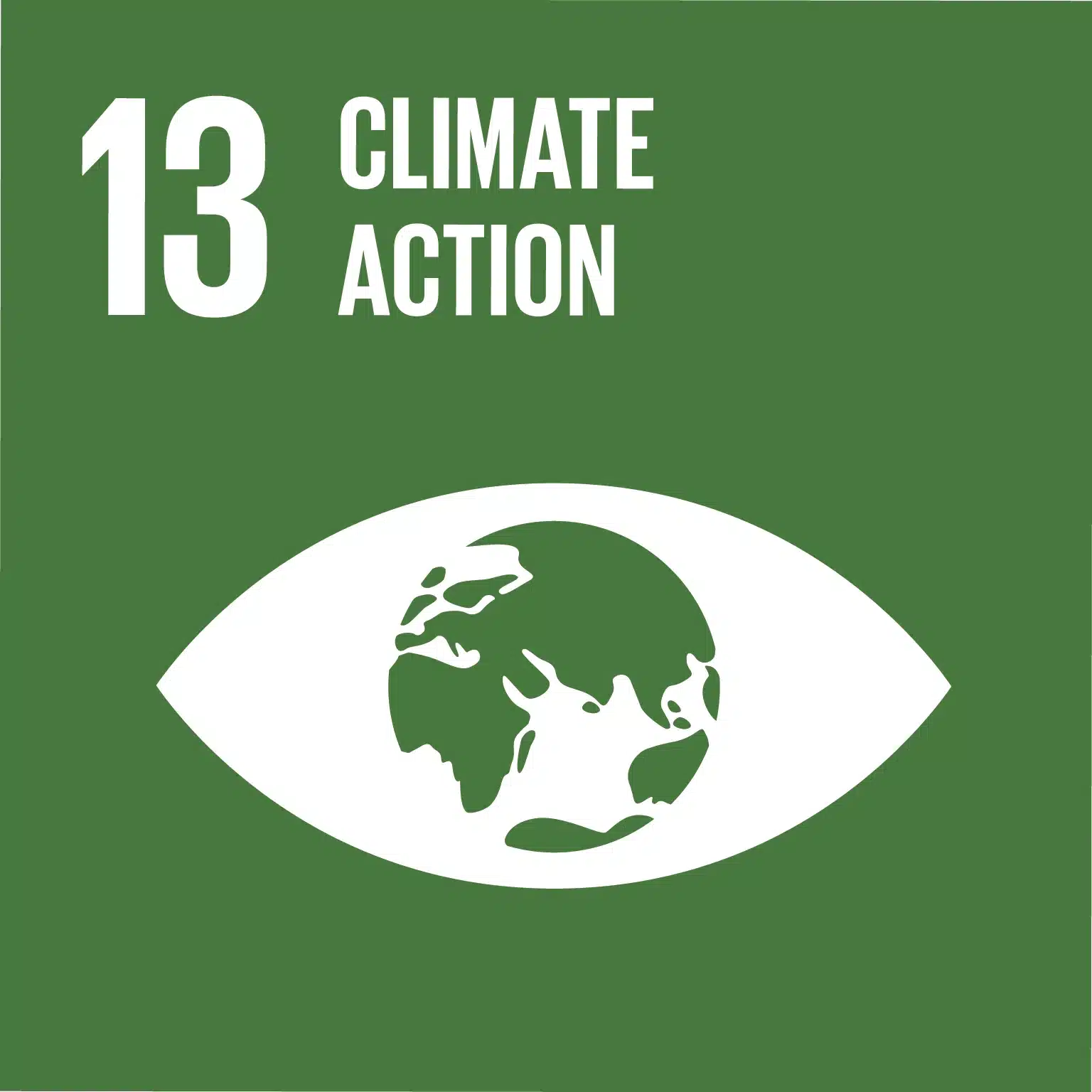
L’Objectif de Développement Durable n° 13 (ODD 13), intitulé « Lutte contre les changements climatiques », appelle à agir d’urgence pour freiner le réchauffement planétaire, réduire les émissions de gaz à effet de serre (GES) et renforcer la résilience face aux aléas climatiques.
Cet objectif est crucial pour limiter la montée du niveau des mers, les phénomènes météorologiques extrêmes et les impacts sur les populations vulnérables comme sur les écosystèmes naturels.
The Sustainable Development Goal No. 13 (SDG 13), entitled “Climate Action,” calls for urgent action to curb global warming, reduce greenhouse gas (GHG) emissions, and strengthen resilience against climate hazards.
This goal is crucial for limiting sea-level rise, extreme weather events, and the impacts on vulnerable populations as well as on natural ecosystems.
SDG 13 relies on several major areas of action:
-
- Strengthening the adaptive capacity of societies and infrastructure in the face of climate risks (Target 13.1);
- Integrating climate change measures into national and industrial strategies (Target 13.2);
- Improving awareness and education on climate change mitigation (Target 13.3);
- Increasing financing and international cooperation in favour of the energy transition (Targets 13.4 and 13.b).
Through the application of our industrial battery regeneration technology, we act directly on reducing emissions and actively participate in the transition towards a low-carbon economy:
-
- Up to 89% of emissions avoided: Each battery that we regenerate emits nearly nine times less than a new battery. This is made possible by eliminating the majority of environmental impacts associated with initial production, transport, and premature recycling of materials.
- Significant reduction in carbon footprint: Regeneration avoids the manufacturing of new batteries, and we thus contribute to limiting emissions from the industrial and energy sectors.
- Support for carbon neutrality: By extending the lifespan of batteries and fostering energy circularity, we align ourselves with the global drive for carbon neutrality by 2050.
- Preservation of natural resources and reduced environmental impact: Limiting the extraction of heavy metals and reducing toxic waste contributes to the global decarbonization of energy sectors.
By integrating battery regeneration at the heart of the energy chain, we demonstrate that it is possible to combine technological innovation, economic performance, and climate responsibility.
Our industrial model fully illustrates the vision of SDG 13: taking concrete action against climate change by transforming the way we produce, consume, and store energy.
Through a circular, local, and decarbonized approach, we contribute to building a sustainable, resilient, and carbon-neutral future, serving an economy that respects the climate and future generations.
Be Energy, a Sustainable and Responsible Partner
The commitment of Be Energy to the Sustainable Development Goals (SDGs) is not theoretical; it is measurable and concrete.
Our battery regeneration and reconditioning technology embodies a real circular economy, where technological innovation, ecology, and energy performance converge.
Our commitment to the Sustainable Development Goals (SDGs) is not theoretical; it is measurable and concrete.
By engaging alongside us, businesses, local authorities, and public stakeholders do much more than just extend the life of their batteries: they become key players in a concrete energy, economic, and environmental transition.Regeneration indeed embodies a virtuous industrial model, both high-performing and responsible, which fully aligns with the Sustainable Development Goals (SDGs) 3, 6, 7, 8, 9, 12, and 13.
By integrating our approach, each client acts directly on several essential levers:
-
- Measurable Environmental Performance: Our circular and low-carbon approach allows for a reduction of up to 89% of emissions linked to battery production and premature recycling. This translates into increased energy sobriety and the preservation of natural resources.
- Economic Control and Reliability: This strategy not only allows you to halve the Total Cost of Ownership (TCO) but also strengthens equipment reliability, thereby optimizing control over operating costs.
A Strategic Competitive Advantage
Beyond the immediate economic benefit, organizations that choose Be Energy gain a major strategic competitive advantage:
-
- CSR and ESG Valuation: They improve their ESG indicators, enhance their CSR image, and anticipate growing regulatory requirements (CSRD, Green Taxonomy, or the new European Battery Regulation).
- Access to Green Financing: This direct alignment with the SDGs opens access to essential financing and incentive schemes such as green loans, ADEME subsidies, or European programs favouring the circular economy.
- Differentiation and Recognition: In a context where public policies and tenders prioritize sustainable practices, this alignment becomes a powerful lever for institutional recognition and commercial differentiation.
Choosing regeneration is also contributing to cleaner, local, and more resilient production: less dependent on critical raw materials, more rooted in local territories, and creator of skilled jobs. It is a comprehensive approach that unites performance, responsibility, and innovation. By collaborating with us, businesses affirm their commitment to “do better with less,” to place their operations on a low-carbon trajectory, and to transform their environmental commitments into genuine economic, political, and societal assets.
Be Energy does not limit itself to extending the life of batteries: we restore meaning, value, and coherence to the way we produce, consume, and invest in a common future.
By choosing Be Energy, you therefore contribute to:
-
- Immediate reduction in your operating costs: Up to 50% savings on battery replacement thanks to regeneration, without any loss of performance or autonomy.
- Optimization of capital assets: Extending the lifespan of equipment avoids heavy investment in new material and improves the overall profitability of assets.
- Privileged access to green financing and CSR tenders: Regeneration aligns with the European Taxonomy, favouring subsidies, impact loans, and sustainable public procurements.
- Strengthening strategic competitiveness: Adopting a patented circular economy solution improves ESG indicators and the extra-financial value of your company.
We choose regenerated energy, a preserved planet, and a sustainable future.
